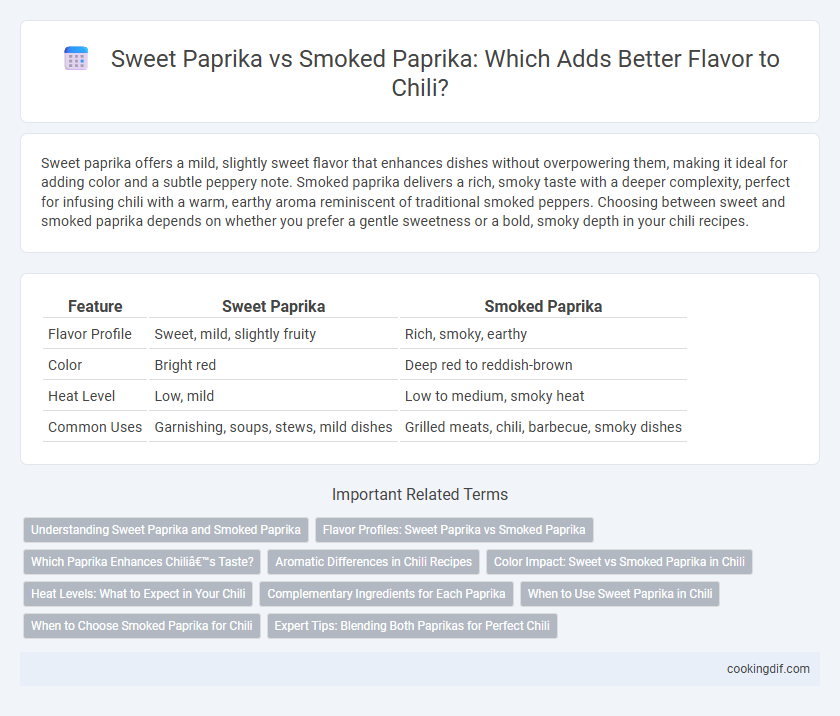Sweet paprika offers a mild, slightly sweet flavor that enhances dishes without overpowering them, making it ideal for adding color and a subtle peppery note. Smoked paprika delivers a rich, smoky taste with a deeper complexity, perfect for infusing chili with a warm, earthy aroma reminiscent of traditional smoked peppers. Choosing between sweet and smoked paprika depends on whether you prefer a gentle sweetness or a bold, smoky depth in your chili recipes.
Table of Comparison
| Feature | Sweet Paprika | Smoked Paprika |
|---|---|---|
| Flavor Profile | Sweet, mild, slightly fruity | Rich, smoky, earthy |
| Color | Bright red | Deep red to reddish-brown |
| Heat Level | Low, mild | Low to medium, smoky heat |
| Common Uses | Garnishing, soups, stews, mild dishes | Grilled meats, chili, barbecue, smoky dishes |
Understanding Sweet Paprika and Smoked Paprika
Sweet paprika offers a mild, subtly sweet flavor derived from dried, ground red bell peppers, making it ideal for adding vibrant color and gentle warmth without heat. Smoked paprika is produced by drying peppers over wood fires, infusing a rich, smoky aroma and deeper flavor complexity that enhances chili dishes with a robust, earthy character. Both varieties originate from Capsicum annuum peppers but differ in processing, directly influencing the flavor profile and culinary applications.
Flavor Profiles: Sweet Paprika vs Smoked Paprika
Sweet paprika offers a mild, slightly sweet flavor derived from dried red peppers, enhancing dishes with vibrant color and subtle sweetness. Smoked paprika delivers a deep, smoky aroma and bold taste achieved through drying peppers over oak fires, adding complexity and warmth to chili recipes. Choosing between sweet and smoked paprika influences the chili's flavor depth, balancing between mellow sweetness and rich smokiness.
Which Paprika Enhances Chili’s Taste?
Sweet paprika adds a mild, slightly sweet flavor that enhances chili by balancing spicy heat without overpowering other ingredients. Smoked paprika introduces a deep, smoky richness that intensifies the chili's complexity and gives it a distinctive, earthy aroma. Choosing between sweet and smoked paprika depends on whether you prefer a subtler sweetness or a robust smoky flavor to elevate your chili's taste.
Aromatic Differences in Chili Recipes
Sweet paprika offers a mild, slightly sweet aroma that enhances chili recipes without overpowering other spices, providing a subtle warmth and vibrant red color. Smoked paprika delivers a robust, smoky aroma that adds depth and complexity, imparting a distinctive charred flavor reminiscent of traditional wood-fire cooking. Choosing between sweet and smoked paprika in chili largely depends on desired aromatic profiles, with sweet paprika prioritizing gentle sweetness and smoked paprika emphasizing intense smoke-infused notes.
Color Impact: Sweet vs Smoked Paprika in Chili
Sweet paprika imparts a vibrant red hue to chili, enhancing its visual appeal with a bright, warm color that complements the dish's ingredients. Smoked paprika adds a deeper, reddish-brown shade, contributing a rich, smoky tint that reflects its intense, earthy flavor profile. The color impact of sweet paprika tends to brighten chili, while smoked paprika creates a more rustic, robust appearance.
Heat Levels: What to Expect in Your Chili
Sweet paprika offers a mild heat level with a subtle sweetness that enhances chili without overpowering the other spices. Smoked paprika provides a deeper, smoky flavor with a slightly higher heat, adding complexity and warmth to chili recipes. Choosing between sweet and smoked paprika depends on whether you prefer a gentle, sweet undertone or a bold, smoky spice in your chili.
Complementary Ingredients for Each Paprika
Sweet paprika's mild, fruity flavor pairs excellently with ingredients like tomatoes, bell peppers, and mild chili powders, enhancing dishes without overpowering them. Smoked paprika, with its rich, smoky depth, complements robust ingredients such as chipotle peppers, cumin, and dark beans, adding complexity and warmth to chili recipes. Using sweet paprika alongside garlic and onion creates a balanced, subtle base, while smoked paprika shines when combined with smoked meats and earthy herbs like oregano and thyme.
When to Use Sweet Paprika in Chili
Sweet paprika adds a mild, slightly sweet flavor that enhances chili without overpowering the other ingredients, making it ideal for recipes needing subtle warmth and rich color. It works best in chili variants focused on deep, balanced taste profiles rather than smoky or intense heat. Use sweet paprika when you want to highlight the natural flavors of tomatoes and beans while adding a gentle warmth to your chili.
When to Choose Smoked Paprika for Chili
Smoked paprika adds a rich, smoky depth to chili, enhancing flavors with its distinct wood-smoked aroma, making it ideal for recipes with robust meats like beef or pork. Use smoked paprika when you want to highlight smoky undertones without overpowering the dish, especially in slow-cooked or grill-inspired chili variations. Sweet paprika provides a milder, sweeter flavor and complements dishes that require balanced warmth without smokiness, whereas smoked paprika intensifies the chili's complexity.
Expert Tips: Blending Both Paprikas for Perfect Chili
Sweet paprika lends a mild, slightly sweet flavor that enhances chili's richness without overpowering the other ingredients, while smoked paprika adds a deep, smoky undertone that intensifies the dish's complexity. Expert tips recommend blending both paprikas to balance sweetness and smokiness, creating a multidimensional chili flavor profile. Use a 2:1 ratio of sweet to smoked paprika to maintain brightness while integrating a subtle smoky depth.
Sweet Paprika vs Smoked Paprika for flavor Infographic

 cookingdif.com
cookingdif.com